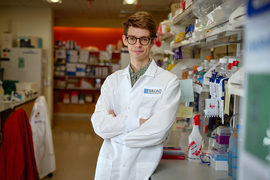Constantine Tzouanas aims to deconstruct, understand, and engineer complex biological systems by studying their smallest units — individual cells.
“The analogy I like to use is whenever you see a broken car, it’s very easy to describe that the windshield is broken, the bumper is crumpled,” says the fourth-year PhD candidate. “It’s much harder to get at the unifying cause and opportunities to intervene, such as worn-out brake pads that led to the crash.”
Under his advisor, Professor Alex Shalek, Tzouanas is leading projects that identify tissue interactions that arise when the body combats infectious diseases and responds to stress. In addition to uncovering leads to new treatments, Tzouanas wants to better understand how the body works as a unified system.
Tzouanas was first drawn to bioengineering as an undergraduate at Rice University. He grew up in Houston, where the proximity to NASA, the Texas Medical Center, and local industry fostered his interest in science and engineering. When it came time to pick a major, he saw bioengineering as a way to blend a variety of his interests to tackle impactful problems.
At the same time, Tzouanas was also nurturing a desire to serve his community. As an undergraduate, he helped implement programs that “lower the activation energy” for students to succeed, by helping them form long-term mentoring relationships with professors and by connecting students’ feedback to department-level curriculum decisions. He’s continued that at MIT, putting together programs to get high school students excited about STEM, and serving as a student representative on the Institute for Medical Engineering and Science Visiting Committee.
“Everyone has someone who first introduces them to STEM and the breadth of what’s possible. Being able to play that role as a graduate student and promote awareness of all these exciting areas is hugely gratifying,” Tzouanas says. “The motivation for service outside of the lab really comes from an appreciation of all the people and mentors who enabled me to become the person I am today.”
Investigating infectious diseases
Tzouanas is pursuing a PhD in medical engineering and medical physics within the Harvard-MIT Program in Health Sciences and Technology, which trains students to conduct strong research while understanding clinical approaches and practices. Studying together, MD and PhD students take classes at both MIT and at Harvard Medical School.
Going into graduate school, he hadn’t expected to dive into infectious disease, but he has found that each project helps him build toward his overall goal of understanding the human body as a system.
“I was definitely seeking out research that would be translational to human health,” says Tzouanas. “It’s very gratifying to see how the areas where I’m investing my time in the lab could eventually lend themselves to new treatments, new diagnostics, and patient impact. The HST program offers a really nice combination of high-level principles of biology and engineering, but also more direct connections to human health and care.”
One area where Tzouanas has co-led projects focuses on understanding how tuberculosis infects the body. Once tuberculosis bacteria reach the lungs, the body forms a dense, multicellular community called a granuloma, where immune and structural cells surround the bacteria. Sometimes the immune system is victorious and kills off the bacteria in the granuloma, but in other cases, the bacteria can survive for years. Even within the same patient, different granulomas can exhibit opposite behaviors, which suggests that understanding these differences in immune function may provide targets for new therapies.
Over the course of this project, Tzouanas and his collaborators identified two distinct tissue ecosystems that help explain why such disparate behavior can be seen in the same host. In one, the body’s structural cells signal among themselves through pathways normally seen in tissue repair and wound healing. This may help wall off the bacteria to prevent further bacterial spreading, but it can also make it more difficult for immune cells to infiltrate and kill the bacteria. In the other scenario, intercellular signaling leads to coordination across multiple immune cell types and associates to mount an effective defense.
By understanding these responses and the circumstances that lead to them, Tzouanas and his team were able to identify particular signaling molecules that could be leveraged for more effective treatments in the future.
The draw of research
Looking ahead, Tzouanas sees wide-ranging potential to use similar techniques to understand the body’s responses to diverse diseases and uncover therapeutic opportunities.
“It’s been exciting to develop foundational experimental and computational skills during my PhD and apply them broadly, like other projects on how smoking history increases tuberculosis risk or how metabolic stress increases cancer risk in the intestine and liver,” Tzouanas says. “By working across all these different areas, I’ve recognized how they’re linked by similar themes on the importance of intercellular and tissue interactions. But these biological applications also have highlighted unmet needs and opportunities where I can create new technologies too, like co-developing tools that connect how cellular functions and interactions vary based on cells’ spatial location in complex tissues.”
Following the completion of his degree, he wants to stay in academia to continue to tackle these high-impact problems that span disciplines.
“There’s something beautiful about how, in research, you can walk into lab every day to think about problems that no one’s thought about before, and work with all of these creative and insightful people across disciplines to produce tools and knowledge that push the boundaries of what’s possible,” says Tzouanas. “The skills and experiences I’ve gained in grad school have really positioned me well for success long-term as a professor and mentor in academia.”












